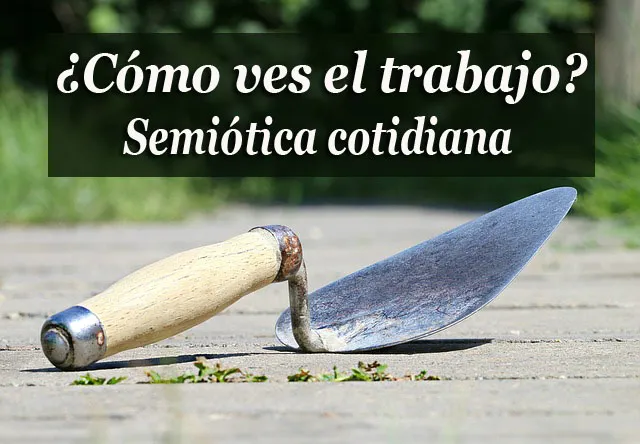
Saludos. Esta semana los amigos de @humanitas nos invitan a reflexionar sobre la semiótica, un tema por demás interesante puesto que los humanos somos seres de interpretación, nos comunicamos básicamente a través de símbolos, los que cobran significación particular dependiendo del entorno cultural y, por supuesto, de nuestra escala de valores.
Para darle concreción a un tema que pudiera ser muy abstracto la invitación recomienda basarnos en el trabajo como valor. La pregunta generadora es ¿qué es el valor del trabajo para ti?, Les comento…
En la imagen de portada (I) se muestra una cuchara de albañilería, en lo que la vi me recordó una concepción del trabajo con la que estuve muy familiarizado durante la infancia y la juventud. Crecí con la idea de que el trabajo era algo rudo, agotador y que se cumplía por obligación.
En ese imaginario una de las referencias era la albañilería, el paradigma del trabajo fuerte. Pero además de ser fuerte también es un trabajo que se puede hacer casi en solitario, sin tener comunicación con nadie. He conocido albañiles que han levantado casas ellos solos, son tan capaces y fuertes que no necesitan ayudantes.
La foto de la cuchara en una calle solitaria produjo en mí una gran resonancia, conectó con esa idea arraigada desde aquellos años; esa primera conexión se da de manera automática, medio inconsciente, el símbolo cumple su trabajo de evocar vivencias. Posteriormente la reflexión me permite interpretar para construir la explicación que les he descrito.
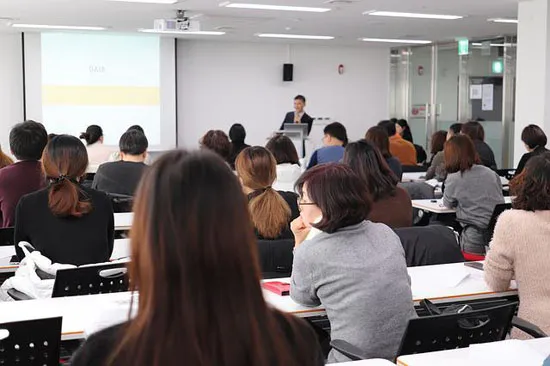
La segunda imagen (II) está mucho más ligada con mis elecciones personales. Desde joven escogí la docencia como profesión. En esa foto se recoge uno de los modelos pedagógicos más extendidos en Occidente, el de un experto que deja sus instrucciones a un grupo de alumnos.
La tónica predominante en la imagen es la de la separación. El docente está separado del auditorio, los alumnos están separados entre sí, cada quien en su mesa de trabajo; la tecnología convierte la pantalla en auxiliar del docente en el proceso de difusión de información, pero siempre en el mismo paradigma de la separación.
A partir de la foto es difícil construir alguna idea de interacción. Cada alumno está en lo suyo, no interactúa con nadie, ni siquiera con el profesor, que por cierto, presta más atención a la pantalla que al auditorio.
Desde mi tiempo de estudiante universitario fui muy crítico con ese modelo pedagógico, me parecía que era poco humano y que representaba una visión autoritaria de la relación pedagógica. En mi concepción del tema cualquier práctica pedagógica debía centrarse en el alumno y para ello es indispensable que el ambiente escolar facilite una relación más horizontal donde el profesor y los alumnos puedan interactuar de manera permanente.
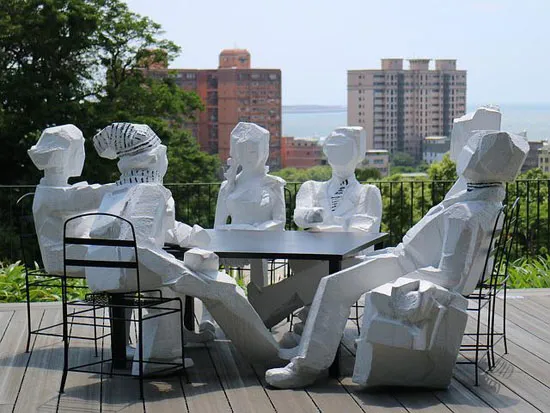
La tercera foto está mucho más acorde con mi idea de lo que debe ser la práctica pedagógica. No encontré la imagen que hubiese querido pero esta recoge bastante bien mi concepción del asunto.
Lo primero que destaca es que todos los sujetos están en el mismo plano, no hay unos más arriba que otros; no hay una representación explícita de la jerarquía.
Otro aspecto a resaltar es la cercanía, todos los sujetos están muy cercanos entre sí; no hay barreras de por medio, no hay nada que los separe. Entre ellos cualquier conversación fluye libremente, están en una relación horizontal donde todos tienen la misma importancia.
También es relevante el ambiente donde se encuentran los sujetos. Están en un entorno abierto, que puede ser cualquier lugar. Acá lo importante no son las estructuras ni las tecnologías, sino la interacción de las personas. Pudiera asemejarse a un encuentro de amigos.
En los años ochenta hubo muchas experiencias educativas que se dieron en los llamados “centros de aula abierta”, eran espacios no convencionales donde alumnos y docentes se relacionaban de otro modo. No sé si haya en la actualidad experiencias de ese tipo.
En mi tiempo de docente trate de poner en práctica el modelo de educación horizontal. Trataba de que mis alumnos sintieran que no estaban por debajo de mí. Cada vez que podía reorganizaba el espacio escolar, rompía la estructura de las filas y colocaba las mesas en círculo. Es impresionante el cambio que se logra en la atención y la participación de los alumnos solamente con ese pequeño cambio. Se entregaban más fácilmente a un proceso donde se sentían participantes de la construcción del conocimiento, en estos tiempos se habla de cocreación.
En la Universidad se facilitaba mucho más esa experiencia. Cualquier sitio del campus universitario era propicio para hacer reuniones, mis alumnos y yo hacíamos conversaciones-clases casi que en cualquier parte. A veces usábamos el aula y otras no. Una situación que no siempre era bien vista por las autoridades, a veces tuve que justificar esa forma de hacer las cosas.
Debo aclarar que no soy ningún experto en semiótica, mis conocimientos sobre el tema son elementales, me he limitado a hacer un ejercicio libre de interpretación sobre tres imágenes que me conectaron con mis ideas sobre el trabajo.
Una vez más agradezco a los amigos de @humantas por brindarnos cada semana espacios para la reflexión.
Gracias por tu tiempo.

Greetings. This week the friends of @humanitas invite us to reflect on semiotics, a very interesting topic since humans are beings of interpretation, we communicate basically through symbols, which acquire particular significance depending on the cultural environment and, of course, on our scale of values.
In order to give concreteness to a subject that could be very abstract, the invitation recommends basing ourselves on work as a value. The generating question is: what is the value of work for you, I tell you?
In the cover image (I) I show you a masonry spoon. As soon as I saw it, it reminded me of a conception of work with which I was very familiar during my childhood and youth. I grew up with the idea that work was something rough, exhausting and that it was done out of obligation.
In that imaginary, one of the references was masonry, the paradigm of hard work. But in addition to being tough, it is also a job that can be done almost alone, without communication with anyone. I have known masons who have built houses by themselves, they are so capable and strong that they don't need helpers.
The photo of the spoon in a lonely street produced in me a great resonance, it connected with that idea rooted since those years; that first connection occurs automatically, half unconsciously, the symbol does its job of evoking experiences. Later, reflection allows me to interpret in order to build the explanation that I have described.

The second image (II) is much more related to my personal choices. Since I was young I chose teaching as a profession. This picture shows one of the most widespread pedagogical models in the West, that of an expert who leaves his instructions to a group of students.
The predominant tone in the image is that of separation. The teacher is separated from the audience, the students are separated from each other, each at his or her own desk; technology turns the screen into an assistant to the teacher in the process of disseminating information, but always in the same paradigm of separation.
From the photo it is difficult to construct any idea of interaction. Each student is on his own, not interacting with anyone, not even with the teacher, who, by the way, pays more attention to the screen than to the audience.
Since my time as a university student I was very critical of this pedagogical model, it seemed to me that it was not very humane and that it represented an authoritarian vision of the pedagogical relationship. In my conception of the subject, any pedagogical practice should be centered in th It is essential that the school environment facilitates a more horizontal relationship where the teacher and the students can interact on a permanent basis.

The third picture is much more in line with my idea of what pedagogical practice should be. I did not find the image I would have liked, but this one captures my conception of the matter quite well.
The first thing that stands out is that all the subjects are on the same plane, there are not some higher than others; there is no explicit representation of hierarchy.
Another aspect to highlight is the closeness, all the subjects are very close to each other; there are no barriers in between, there is nothing that separates them. Between them any conversation flows freely, they are in a horizontal relationship where everyone has the same importance.
Also relevant is the environment where the subjects are. They are in an open environment, which can be anywhere. Here the important thing is not the structures or technologies, but the interaction of people. It could be similar to a meeting of friends.
In the eighties there were many educational experiences in the so-called "open classroom centers", non-conventional spaces where students and teachers interacted in a different way. I don't know if there are any such experiences nowadays.
In my time as a teacher, I tried to put the horizontal education model into practice. I tried to make my students feel that they were not below me. Whenever I could, I reorganized the school space, broke the structure of the rows and placed the tables in a circle. It is impressive the change in student attention and participation that is achieved with just that small change. They surrendered more easily to a process where they felt they were participants in the construction of knowledge; nowadays we talk about co-creation.
At the University, this experience was much easier. Any place on the university campus was conducive to hold meetings, my students and I held conversations-classes almost anywhere. Sometimes we used the classroom and sometimes we did not. A situation that was not always well seen by the authorities, sometimes I had to justify that way of doing things.
I must clarify that I am no expert in semiotics, my knowledge on the subject is elementary, I have limited myself to make a free exercise of interpretation on three images that connected me with my ideas about the work.
Once again I thank the friends of @humantas for providing us with spaces for reflection every week.
Thank you for your time.
Translated with www.DeepL.com/Translator

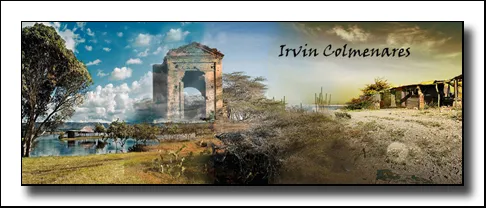


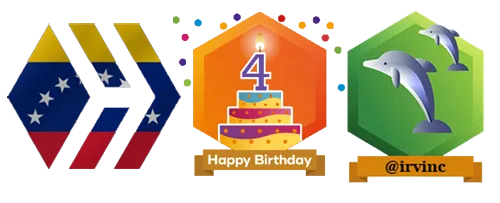

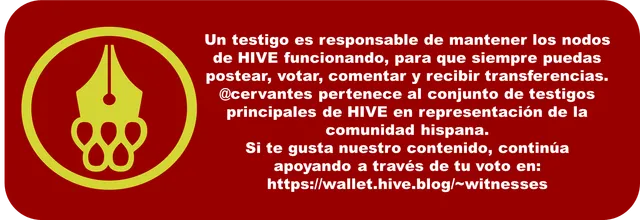
Te invito a apoyar este proyecto como witness y a formar parte de esta gran comunidad uniéndote a su Discord en el siguiente enlace:
Discord de la comunidad Cervantes

You can vote for @ocd-witness, with HiveSigner or on Hive Witnesses.


Banner obsequio de los amigos de @rutablockchain
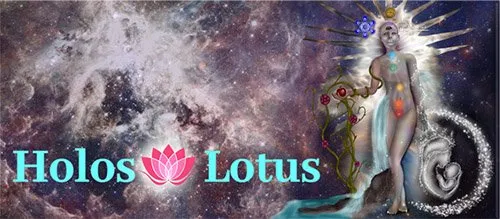



Banner obsequio de los amigos de @rutablockchain


